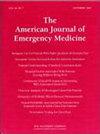在急诊科实施无症状高血压评估临床路径
IF 2.7
3区 医学
Q1 EMERGENCY MEDICINE
引用次数: 0
摘要
导言根据美国心脏协会和美国急诊医师学会的指南,急诊科(ED)没有立即降低无症状高血压的指征,也不要求对这些患者进行常规诊断检测。尽管如此,无症状高血压仍是其他医疗机构或患者自我转诊到急诊科进行评估的一个经常性转诊来源,而且在评估和治疗这一主诉方面存在着显著的实践差异。方法这是一项前后期研究,目的是对因无症状高血压而到退伍军人健康管理局三级学术急诊科就诊的患者进行标准化治疗。纳入标准为通过病历审查确认在2018年至2022年期间因血压读数升高的主诉而就诊的具有ICD10编码的高血压患者,该路径已于2022年开始实施。如果患者有胸痛、头痛或气短等高血压可能导致的终末器官病变症状,或者是未接受绝育手术的育龄妇女,则排除在外。主要结果是急诊室就诊后 30 天内的主要心血管不良事件。次要结果包括:进行的诊断测试、在急诊室使用的降压药和住院时间。结果共有 295 名患者和 324 次就诊符合纳入/排除标准,其中 46 次就诊发生在路径实施之后。实施路径前后均未发生重大不良心血管事件。实施路径后,胸片检查率从 10% 降至 0%(p = 0.005)。实验室检测、心电图和口服降压药的使用也有所减少,但这些差异在统计学上并不显著。任何诊断测试都没有发现任何之前未诊断出的病症。实施路径后,没有出现静脉注射高血压药物的情况。结论:我们的研究结果再次证明,无症状高血压患者在急诊室就诊时发生高血压短期并发症的风险很低,而且诊断性检查在这一人群中的应用率也很低。虽然我们能够减少不必要的检查,但还需要进一步开展工作,教育临床医生并在护理这些患者时更好地遵守循证原则。本文章由计算机程序翻译,如有差异,请以英文原文为准。
Implementation of a clinical pathway for the evaluation of asymptomatic hypertension in the emergency department
Introduction
According to the guidelines of the American Heart Association and American College of Emergency Physicians, respectively, there is no indication for immediate lowering of asymptomatic hypertension in the Emergency Department (ED), and no requirement for routine diagnostic testing in these patients. Despite this, asymptomatic hypertension represents a recurring source of referrals for ED evaluation from other healthcare settings, or from patient self-referral, with significant practice variation in the evaluation and treatment of this complaint.
Methods
This is a pre-post study of a pathway to standardize care of patients presenting to a tertiary academic Veteran's Health Administration ED with asymptomatic hypertension. Inclusion criteria were patients with ICD10 codes of hypertension who were confirmed via chart review to have sought care for a complaint of elevated blood pressure readings from 2018 to 2022, with the pathway having been implementing in 2022. Patients were excluded if they had symptoms of possible end organ pathology due to hypertension, such as chest pain, headache, or shortness of breath, or if they were reproductive age women who had not undergone a sterilization procedure. The primary outcome was major adverse cardiovascular event within 30 days of ED visit. Secondary outcomes included: diagnostic tests performed, administration of antihypertensives in the ED, and length of stay. Descriptive statistics and statistical analysis were performed.
Results
There were a total of 295 unique patients and 324 patient encounters that met the inclusion/exclusion criteria, with 46 encounters that took place after pathway implementation. There were no major adverse cardiovascular events either before or after pathway implementation. Chest radiographs were reduced from 10 % to 0 % (p = 0.005) after pathway respectively. There were also declines in laboratory testing, EKGs, and administration of oral antihypertensives, but these differences were not statistically significant. At no point did any diagnostic testing identify any previously undiagnosed medical conditions. There were no instances of intravenous hypertensives being given after pathway implementation. Despite the reductions in diagnostic testing, there was no change in ED length of stay for patients with asymptomatic hypertension.
Conclusion
Our findings redemonstrate that patients presenting to the ED with asymptomatic hypertension are at low risk for short-term complications of hypertension, and that diagnostic testing is low yield in this population. While we were able to achieve reductions in unnecessary testing, further work is needed to educate clinicians and improve adherence to evidence based principles when caring for these patients.
求助全文
通过发布文献求助,成功后即可免费获取论文全文。
去求助
来源期刊
CiteScore
6.00
自引率
5.60%
发文量
730
审稿时长
42 days
期刊介绍:
A distinctive blend of practicality and scholarliness makes the American Journal of Emergency Medicine a key source for information on emergency medical care. Covering all activities concerned with emergency medicine, it is the journal to turn to for information to help increase the ability to understand, recognize and treat emergency conditions. Issues contain clinical articles, case reports, review articles, editorials, international notes, book reviews and more.

 求助内容:
求助内容: 应助结果提醒方式:
应助结果提醒方式:


